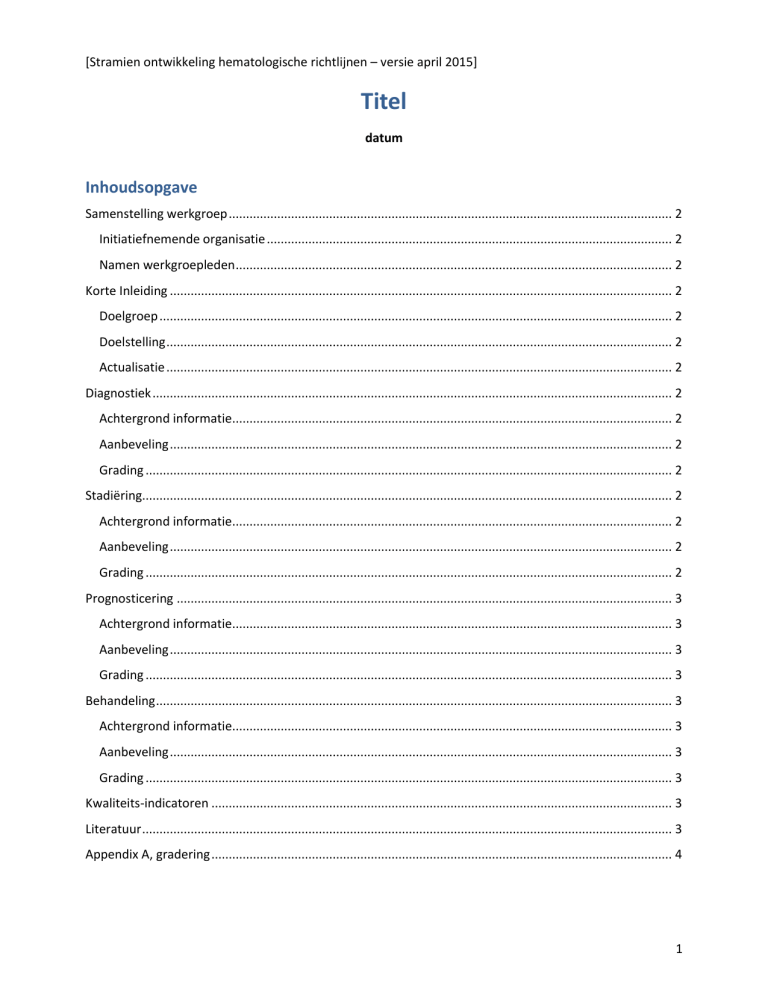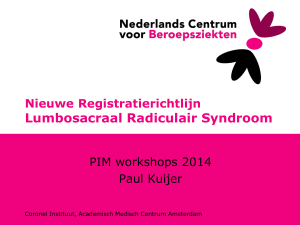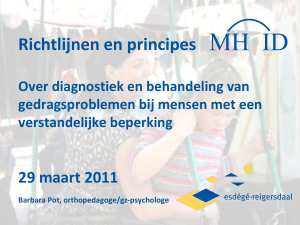
[Stramien ontwikkeling hematologische richtlijnen – versie april 2015]
Titel
datum
Inhoudsopgave
Samenstelling werkgroep ................................................................................................................................ 2
Initiatiefnemende organisatie ..................................................................................................................... 2
Namen werkgroepleden .............................................................................................................................. 2
Korte Inleiding ................................................................................................................................................. 2
Doelgroep .................................................................................................................................................... 2
Doelstelling .................................................................................................................................................. 2
Actualisatie .................................................................................................................................................. 2
Diagnostiek ...................................................................................................................................................... 2
Achtergrond informatie............................................................................................................................... 2
Aanbeveling ................................................................................................................................................. 2
Grading ........................................................................................................................................................ 2
Stadiëring......................................................................................................................................................... 2
Achtergrond informatie............................................................................................................................... 2
Aanbeveling ................................................................................................................................................. 2
Grading ........................................................................................................................................................ 2
Prognosticering ............................................................................................................................................... 3
Achtergrond informatie............................................................................................................................... 3
Aanbeveling ................................................................................................................................................. 3
Grading ........................................................................................................................................................ 3
Behandeling ..................................................................................................................................................... 3
Achtergrond informatie............................................................................................................................... 3
Aanbeveling ................................................................................................................................................. 3
Grading ........................................................................................................................................................ 3
Kwaliteits-indicatoren ..................................................................................................................................... 3
Literatuur ......................................................................................................................................................... 3
Appendix A, gradering ..................................................................................................................................... 4
1
Samenstelling werkgroep
Initiatiefnemende organisatie
Namen werkgroepleden
Korte Inleiding
Doelgroep
Doelstelling
Actualisatie
Uiterlijk 2 jaar na verschijnen van de definitieve richtlijn zal worden beoordeeld of herziening nodig is.
Wanneer ontwikkelingen in de toekomst het eerder noodzakelijk maken deze richtlijn te herzien, zal de
richtlijn vóór de termijn van 2 jaar vervallen en zal een herzieningsprocedure worden gestart
Diagnostiek
Achtergrond informatie
Aanbeveling
Grading
Stadiëring
Achtergrond informatie
Aanbeveling
Grading
2
Prognosticering
Achtergrond informatie
Aanbeveling
Grading
Behandeling
Achtergrond informatie
Aanbeveling
Grading
Kwaliteits-indicatoren
Literatuur
3
Appendix A, gradering
Strength-of-Recommendation Taxonomy (SORT)
Code Definition
A
Consistent, good-quality patient-oriented evidence *
B
Inconsistent or limited-quality patient-oriented evidence *
C
Consensus, disease-oriented evidence *, usual practice, expert opinion, or case series for studies
of diagnosis, treatment, prevention, or screening
* Patient-oriented evidence measures outcomes that matter to patients: morbidity, mortality, symptom
improvement, cost reduction, and quality of life. Disease-oriented evidence measures immediate, physiologic, or
surrogate end points that may or may not reflect improvements in patient outcomes (e.g. blood pressure, blood
chemistry, physiologic function, pathologic findings).
Assessing Quality of Evidence
Study
Diagnosis
Treatment/prevention/
Prognosis
quality
screening
Level
1: Validated clinical decision SR/meta-analysis or RCTs SR/meta-analysis of goodgoodrule
with consistent findings
quality
quality,
SR/meta-analysis of high- High-quality
individual cohort studies
patientquality studies
RCT†
Prospective cohort study with
oriented
High-quality
diagnostic All-or-none study‡
good follow-up
evidence
cohort study*
Level
2: Unvalidated clinical decision SR/meta-analysis of lower SR/meta-analysis of lower
limitedrule
quality clinical trials or of
quality cohort studies or with
quality
SR/meta-analysis of lower studies with inconsistent
inconsistent results
quality studies or studies findings
Retrospective cohort study
with inconsistent findings
Lower quality clinical trial or prospective cohort study
Lower quality diagnostic Cohort study
with poor follow-up
cohort study or diagnostic Case-control study
Case-control study
case-control study
Case series
Level
3: Consensus guidelines, extrapolations from bench research, usual practice, opinion,
other
disease-oriented evidence (intermediate or physiologic outcomes only), or case series for
evidence
studies of diagnosis, treatment, prevention, or screening
*High-quality diagnostic cohort study: cohort design, adequate size, adequate spectrum of patients, blinding, and a
consistent, well-defined reference standard.
†High-quality RCT: allocation concealed, blinding if possible, intention-to-treat analysis, adequate statistical power,
adequate follow-up (greater than 80 percent).
‡In an all-or-none study, the treatment causes a dramatic change in outcomes, such as antibiotics for meningitis or
surgery for appendicitis, which precludes study in a controlled trial.
(SR = systematic review; RCT = randomized controlled trial)
4
Consistency Across Studies
Consistent
Inconsistent
Most studies found similar or at least coherent conclusions (coherence means that
differences are explainable).
or
If high-quality and up-to-date systematic reviews or meta-analyses exist, they
support the recommendation.
Considerable variation among study findings and lack of coherence
or
If high-quality and up-to-date systematic reviews or meta-analyses exist, they do
not find consistent evidence in favor of the recommendation.
Algorithm: assigning a Strength-of-Recommendation grade based on a body of
evidence
Is this a key recommendation for clinicians regarding diagnosis or
treatment that merits a label?
no
Strength of Recommendation
not needed
yes
Is the recommendation based on patient-oriented evidence (i.e.,
an improvement in morbidity, mortality, symptoms, quality of
life, or cost)?
no
yes
Is the recommendation based on expert opinion, bench
research, a consensus guideline, usual practice, clinical
experience, or a case series study?
Strength of Recommendation = C
yes
no
Is the recommendation based on one of the following?
• Cochrane Review with a clear recommendation
• Consistent findings from at least two good-quality randomized
controlled trials or a systematic review/meta-analysis of same
• Validated clinical decision rule in a relevant population
• Consistent findings from at least two good-quality diagnostic
cohort studies or systematic review/meta-analysis of same
yes
Strength of Recommendation = A
no
Strength of Recommendation = B
5
Appendix B, verantwoording
Totstandkoming werkgroep/werkwijze
Onafhankelijkheid
Alle werkgroepleden hebben verklaard onafhankelijk gehandeld te hebben bij het opstellen van de
richtlijn. Aan de werkgroepleden is gevraagd een belangenverklaring in te vullen, waarin ze hun banden
met de farmaceutische industrie aangeven (zie bijlage [___]).
Betrokken organisaties /wetenschappelijke verenigingen
Initiatiefnemer: werkgroep [naam] van [naam organisatie]
[aanvullen met overige bij totstandkoming betrokken (patiënten)organisaties].
Implementatie
De conceptrichtlijn is voor commentaar aangeboden aan de leden van de Nederlandse Vereniging voor
Hematologie (NVvH). Het commentaar geeft input vanuit het veld om de kwaliteit en de toepasbaarheid
van de richtlijn te optimaliseren en landelijk draagvlak voor de richtlijn te genereren. Circa [___]
respondenten maakten van deze mogelijkheid gebruik. Alle commentaren werden vervolgens beoordeeld
en verwerkt door de werkgroep. De richtlijn werd op [___] door de [naam] werkgroep inhoudelijk
vastgesteld. Ten slotte is de richtlijn ter autorisatie gestuurd naar [Stichting HOVON en eventuele andere
betrokken (patiënten)organisaties en] de Nederlandse Vereniging voor Hematologie.
In de verschillende fasen van de ontwikkeling van het concept van de richtlijn is zoveel mogelijk rekening
gehouden met de implementatie van de richtlijn en de daadwerkelijke uitvoerbaarheid van de
aanbevelingen.
Om het gebruik in de dagelijkse praktijk te bevorderen wordt deze richtlijn verspreid onder de
professionals van de bij de totstandkoming van deze richtlijn betrokken organisatie(s):
•
•
•
Per mail naar de leden van de NVvH
Publicatie (link naar) richtlijn op website [NVvH / HOVON/separate richtlijnen website]
Integrale publicatie in Nederlands Tijdschrift voor Hematologie [eventueel met uitgebreidere
toelichting]
Revisie
Richtlijnen ondergaan een periodieke (minimaal 1 x per 2 jaar) revisiecyclus.
6












